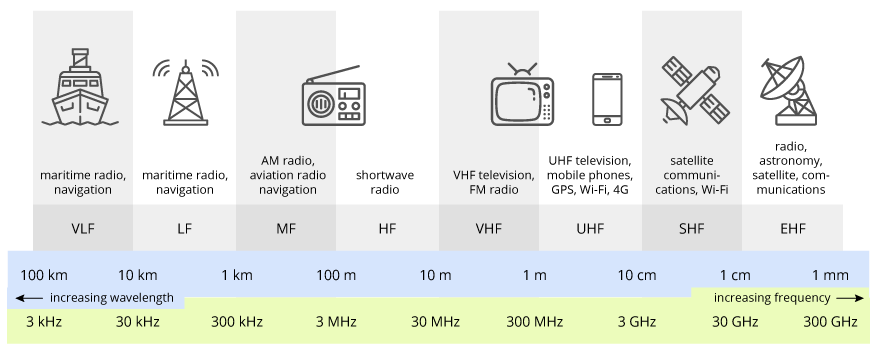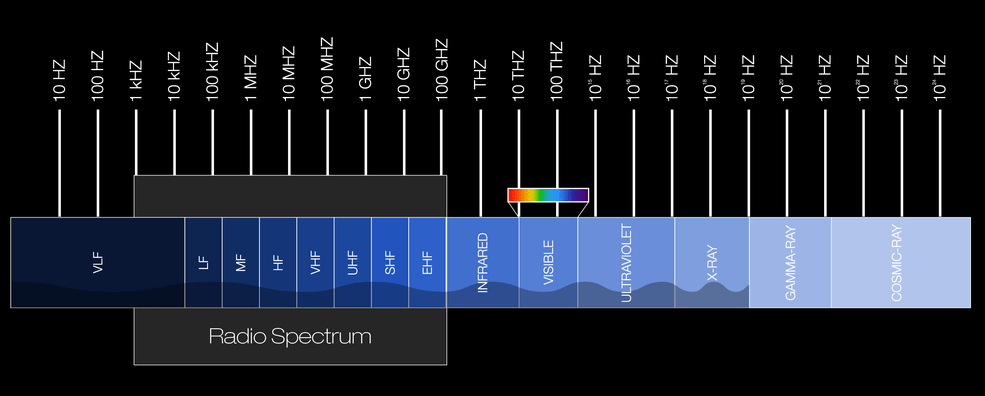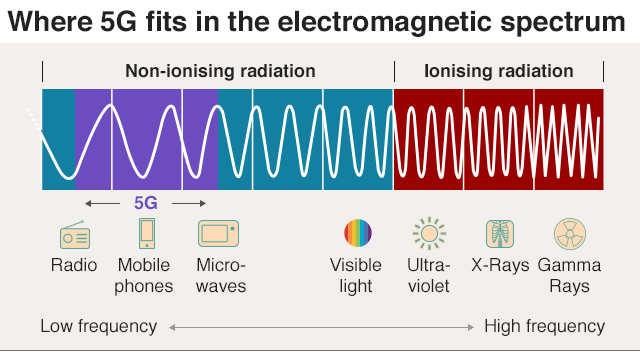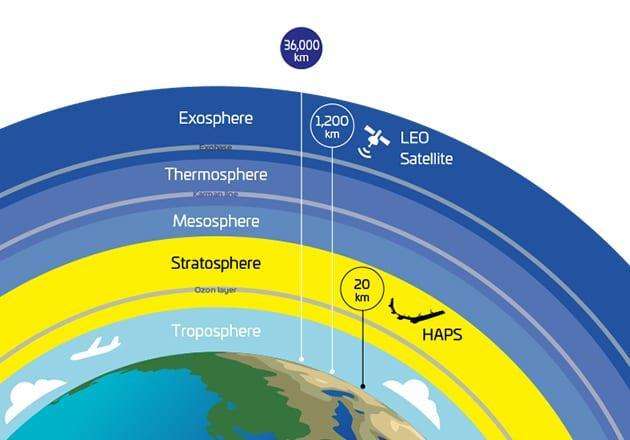Adequate spectrum access is critical to support the growing deployment and coverage of telecommunication networks and meet the ever-increasing demand for data services.
The following article discusses the wireless spectrum, spectrum management, its know-how and requirements with respect to the key trends in radio frequency spectrum management. In addition, the article highlights how the spectrum in wireless communication is a precious resource and how high-band spectrum demands affect the management of the spectrum.
Contents
How does a wireless spectrum work?
Signals flow from their source to a receiver via radio frequency in wireless communication. Everything from television to radio to GPS and cell phone services use this method to deliver data in bits via the air. The wireless spectrum is a collection of radio frequencies that are available for transmission.
Cellular communications can utilize a wide range of spectrum frequencies, hence different bands have slightly distinct properties. Wireless spectrum can be divided into three groups for wireless communication: low-, mid-, and high-band spectrum.
All three are required for reliable spectrum 5G networks. This is because each band of the spectrum is required for a specific type of communication and application:
- Low-band spectrum (less than 3 GHz) can traverse longer distances with less signal disruption. Wireless communications inc. utilize low-band spectrum to develop today’s wireless networks. Wireless can exploit this spectrum to build high-speed wireless networks that cover 99.7% of Americans.
- High-band spectrum (above 24 GHz), when compared to low-band spectrum, covers far shorter distances—think metres, not miles—but provides great capacity and ultra-fast speeds.
- Mid-band spectrum (between 3 and 24 GHz) combines low- and high-band properties to provide a mix of coverage and capacity. E.g., the IoT spectrum.
Certain wireless spectrum frequencies are communicated between cell sites and our mobile devices. The 150-foot cell towers that we are accustomed to seeing along roads or atop towering buildings are today’s most popular cell sites. Tiny cells, or small-scale antennas, are presently being installed rapidly to densify network coverage and provide more frequent connection sites for mid and high-band spectrum 5G.
How does a wireless spectrum work?
Any wireless system from our smartphone to our home Wi-Fi is powered by the RF (radio frequency) spectrum, which is a part of the electromagnetic (EM) spectrum.
Radio transmissions are sent through invisible airways known as spectrums in all kinds of modern communication. The RF spectrum is separated into frequency ranges based on how they are used. These bands make up a minor part of the electromagnetic spectrum, including visible light, X-rays, and other wavelengths. The different frequency bands, along with those of the radio frequency spectrum, are depicted below:
The wireless spectrum is the collection of radio frequencies available for transmission. Signals flow from their source to a receiver via radio frequency in wireless communications. Everything from radar and radio broadcasting to IoT wireless technology like bluetooth, Wi-Fi and every cell phone service is an example of a wireless system that uses this method to deliver data in bits via the air.
When we tune a radio station to our selected channel, we are essentially instructing the radio which frequency to ‘listen to,’ and hence which stream of data to convert to audio output. Interference and distortion would arise if two radio stations are broadcasted on the same frequency, at the same time and in the same area. Therefore, no two radio stations transmit on the same frequency, at the same time, or in the same area.
This is true for every form of service that sends or receives data using radio waves.
Is measuring spectrum important?
It is important to measure the spectrum of known and unknown signals. Given the difficulty of describing the behaviour of today’s radio frequency devices, understanding how frequency, amplitude, and modulation parameters react across short and long time intervals is essential.
Spectrum is measured to:
- Translate higher frequencies (often up to several tens of GHz) into quantifiable values.
- Track frequency of sources of interference to wireless networking equipment, such as Wi-Fi and wireless routers.
- Observe the dominant power, frequency, bandwidth, distortion, harmonics, and other components of a spectrum signal like 5G wireless frequency.
- Test the frequency response, noise, and distortion characteristics of the various types of radio-frequency (RF) equipment.
- Assess occupied bandwidth and track interference sources in telecommunications. For e.g., identify interference sources in the GSM and UMTS frequency ranges.
- Examine the harmonics of an audio signal.
What are the technological innovations driving new spectrum demand?
While the most prevalent spectrum usage seen in telecommunication and IoT wireless networks have been of the low- and mid-band spectrum to date. The increasing interest in 5G wireless spectrum and high-band spectrum usage, such as millimetre wave (mmWave) ranging between 24 GHz and 86 GHz, has drawn much attention. Some countries are looking into the possibility of using frequencies as high as 200 GHz.
Therefore the demand for access to other segments of spectrum frequencies in the wireless frequency range is growing. For example, in the low-, mid-, and high-band spectrum, International Mobile Telecommunications (IMT) applications are based on the fifth generation of mobile technology (high-band spectrum 5G) and are currently competing with incumbent services.
As a result of the growing demand, efficient spectrum usage becomes even more critical. Furthermore, technologies such as HAPS and NGSO satellites have boosted the demand for higher spectrum frequency bands. At the same time, gadgets using IoT in wireless communication like Bluetooth and Wi-Fi have grown. This increases competition for the limited spectrum.
What is spectrum management?
The invisible radio frequencies that wireless signals travel over are referred to as spectrum.
While radio spectrum or wireless spectrum refers to the entire range of wireless communication frequency bands used, which ranges from 1 Hz to 3000 GHz (3 THz), the process of managing the use of radio frequencies in order to encourage efficient utilization and obtain a net social benefit is known as spectrum management.
Importance of spectrum management for wireless network
The spectrum is unique because it is both non-exhaustible and non-storable as an economic resource. Technological advancements such as wireless communication in IoT, high spectrum 5G, etc., are becoming the primary way of connecting businesses and families to phone, data, and media services. Therefore, effective RF spectrum management can greatly impact a country’s prosperity.
The examples in the preceding section demonstrate how new technologies make use of frequency bands. It’s worth noting that these technologies also provide technical breakthroughs that make the existing spectrum more efficient.
Spectrum management is crucial for governments to make the most use of a limited public resource. With an increasing demand for spectrum, competition for certain frequency bands will intensify, making efficient use of that spectrum even more vital.
Effective
Spectrum
management
is required to:
- Preserve key service frequencies from dangerous interference
- Find possibilities to increase efficiency
- Enable the development and deployment of new technologies within flexible frameworks
- Lower the cost of telecommunications equipment
Emerging countries are facing bigger communication and information policy and regulatory change concerns. Therefore, it is becoming clear that spectrum wireless services surpass landline connectivity, and the spotlight focuses on present spectrum management methods.
Effective spectrum management policy should promote the rollout of services and the removal of obstacles to entry and innovation in a globalising society with rapid technological innovation and increasing demand for radio spectrum frequencies.
Elements of spectrum management
There is a managing group or agency in every part of the world. They maintain, assign, and auction spectrum frequencies to firms or organizations who subsequently use that section of the spectrum for their services (typically part of the government or collection of governments in the broadcast area).
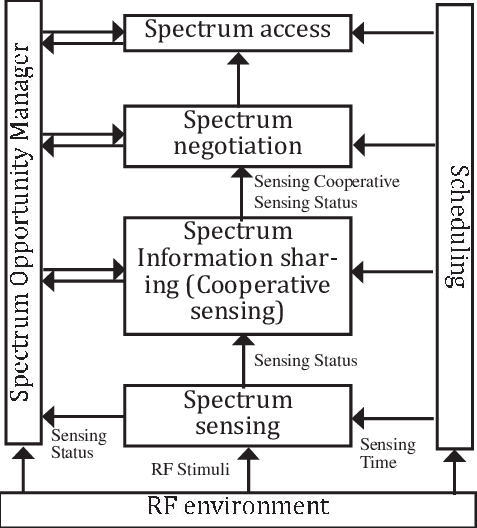
The wireless spectrum is allocated for specific uses, and spectrum managers develop specific technical and service rules to govern those allocations. Spectrum management consists of four primary areas of work:
Spectrum planning: Spectrum planning entails allocating specific portions of the frequency spectrum to certain users. This is done according to international agreements, technical characteristics and possible uses of various parts of the spectrum. National goals and policies are also taken into consideration.
Spectrum authorisation: This entails authorising access to the spectrum resource to various types of radio communication equipment under certain circumstances and radio operator certification.
Spectrum engineering: The establishment of electromagnetic compatibility standards for equipment that emits or is vulnerable to radio waves is known as spectrum engineering.
Spectrum monitoring: Spectrum monitoring and compliance include keeping track of how the radio spectrum is being used and putting in place controls to prevent unlawful use.
Efficient use of the spectrum:
Economically efficient use of spectrum
As a starting point, economically efficient spectrum wireless network utilisation involves maximising the value of outputs created from the available spectrum. These include valuing public outputs provided by the government or other public authorities.
Technically efficient use of spectrum
At its most fundamental level, technically efficient spectrum use is making the most of all available spectrum frequencies. The occupancy and data rate are two indicators of technical efficiency. Time can be used to gauge technical efficiency by determining how consistent or heavy spectrum utilization is over time. For a certain amount of spectrum capacity, data can measure how information may be transferred.
Spectrum management trends for emerging technologies
The following are the key trends driving the future usage of spectrum in wireless communication, outlining some of the primary themes:
- The following is a representation comparing three unlicensed spectrum frequencies:
There are more bands that can currently be used without a spectrum licence in several countries and the usual Wi-Fi licence-exempt channels. They are; 24 GHz band, 60 GHz (V-band), and from 71 GHz onwards (E-band). Small operators and community networks could use these frequencies to provide “fibre-like” access. The fast adoption of a license-free wireless spectrum in the form of Wi-Fi demonstrates the power of frictionless innovation and the unmet demand for affordable internet access.
- Specific regulators have expanded the usage of frequency spectrum used in wireless communication, such as the 11 GHz for fixed PtP backhaul links. This is due to reduced detrimental interference from antennas that may focus wireless communication along relatively narrow beams/paths.
- An analysis of the economic cost of the underutilized spectrum and measures to promote its usage might aid in making a case for this. This could be a particularly effective technique for preventing the digital gap from widening due to the future 5G spectrum and wireless communication in IoT assignments.
FAQs:
- Who manages the spectrum use?
- What is telecom spectrum management?
- Which is responsible for frequency spectrum management?
- What are the parameters of spectrum management?
- Rationalize and optimize the use of the radio frequency spectrum
- Avoid and resolve interference
- Design short and long-range frequency allocations
- Accelerate the introduction of new wireless technologies and wireless deployment.
- Coordinate wireless communications with neighbours and other government agencies.
- Who owns the wireless spectrum?
- What does a spectrum manager do?
The majority of countries regard the radio frequency spectrum as a state-owned asset. The United Nations International Telecommunication Union (ITU) constitution fully recognizes every country’s sovereign authority to govern its telecommunication.
For the non-governmental application of the spectrum, the Federal Communications Commission (FCC) is in charge. For governmental applications, the National Telecommunications and Information Administration (NTIA) manage it.
The spectrum frequencies are broken down into numerous frequency bands, each with its own set of uses. The wireless frequency bands 300 kHz to 535 kHz, for example, are designated for aeronautical and maritime communications. This is referred to as “allocation.”
The spectrum frequencies for telecommunications start at 800 MHz and run all the way up to 2300 MHz. After that, there are the unlicensed bands, which are used for technology like Wi-Fi and Bluetooth. Wi-Fi used to operate at 2.4GHz (2400MHz), but it has begun to migrate to higher frequency ranges.
Telecom spectrum management is the process of regulating radio frequency use in order to promote efficient use of spectrum wireless service, allowing us to conduct phone calls, use social media etc., on our phones.
The International Telecommunication Union (ITU) is where discussions about new sorts of telecommunications and radiofrequency spectrum management take place. Every three or four years, World Radio-communication Conferences (WRCs) are held to discuss revisions to the Table of Allocations.
The National Telecommunications and Information Administration (NTIA) is in charge of spectrum issues that affect federal government customers across all branches in the US. FCC is in charge of spectrum issues for both private users and state and municipal governments.
In India, The National Radio Regulatory Authority, the branch of the Ministry of Communications, is responsible for Frequency Spectrum Management.
As new technologies enable a wider range of applications to utilise a wider range of frequency bands, spectrum management maximizes the use of finite spectrum resources. It fulfils the potential consumer benefits of these new technologies and broader societal and economic purposes. Effective management of conflicting spectrum demands is required, with the overall goal of expanding access to a connection. The parameters of spectrum management are:
Spectrum licences are given out by the government and are owned by corporations in the telecommunications industry.
In the US, according to a Wall Street Journal article, AT&T, Dish, and T-Mobile, in a Federal Communications Commission (FCC) auction, purchased spectrum 5G licences in the midrange 3.45GHz to 3.55GHz band (WSJ). Verizon Wireless paid $3.6 billion for spectrum licensing.
In India, Airtel and Vodafone Idea have worked with Ericsson and Nokia to test 5G spectrum technologies and use cases, while Jio is testing its own 5G RAN and core.
A spectrum manager (SM) is in charge of making critical choices and initiating the appropriate events and activities in order to maintain incumbent protection and efficient spectrum utilization while adhering to regulatory standards. The spectrum manager is in charge of administering the licensed spectrum sharing among the incumbent VNOs. Unlicensed spectrum frequencies should be used opportunistically wherever possible to help alleviate spectrum scarcity.


